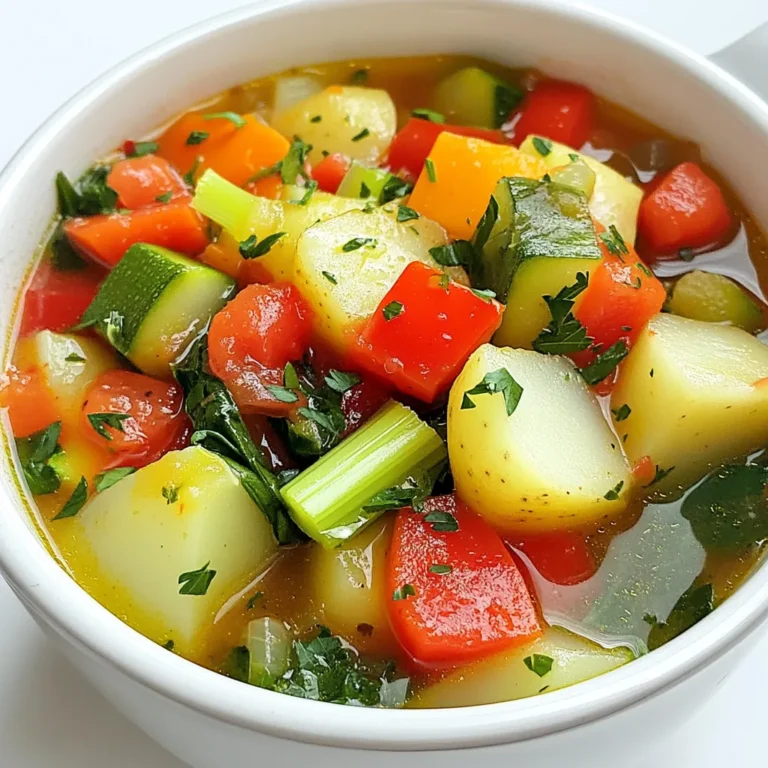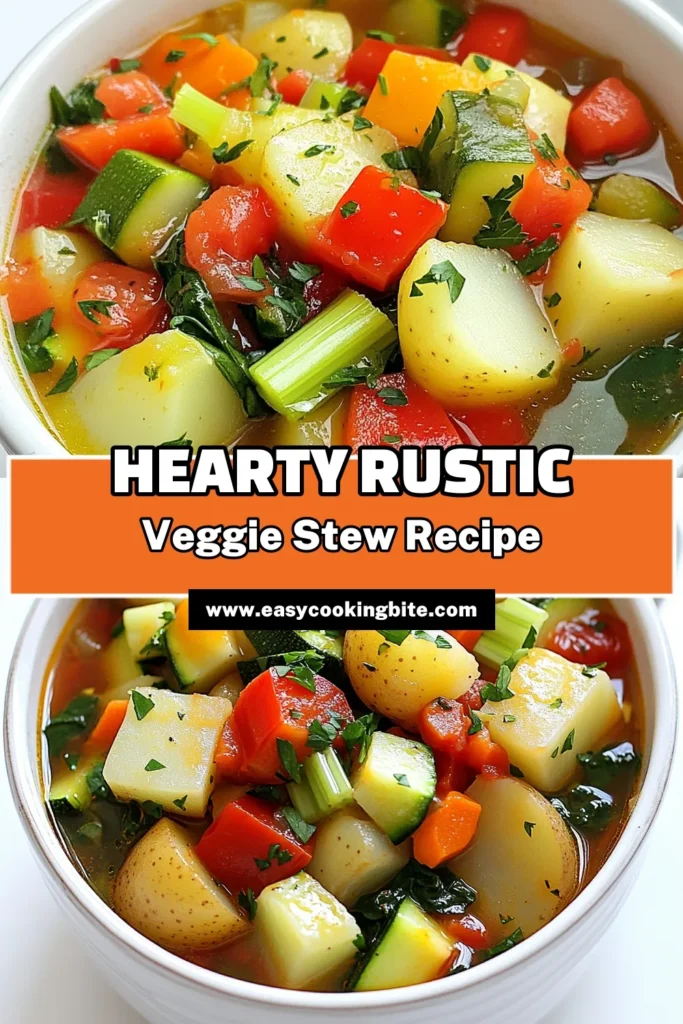Looking for a warm, hearty meal that’s easy to make? This Slow Cooker Rustic Veggie Stew is packed with fresh veggies and rich flavors. You’ll love how simple it is! With just a few ingredients and a slow cooker, you can create a cozy dish that warms the soul. Let’s dive into this timeless comfort food and transform your kitchen into a haven of delicious aromas!
Ingredients
Detailed list of ingredients
For this Slow Cooker Rustic Veggie Stew, you will need fresh vegetables and pantry staples. Here is a complete list:
– Fresh vegetables:
– 4 medium potatoes, diced
– 3 carrots, sliced
– 2 celery stalks, chopped
– 1 zucchini, diced
– 1 red bell pepper, diced
– 1 yellow onion, chopped
– 4 cloves garlic, minced
– 2 cups fresh spinach
– Pantry staples:
– 1 can (14.5 oz) diced tomatoes, with juice
– 4 cups vegetable broth
– 1 tablespoon olive oil
– Seasoning:
– 1 teaspoon dried thyme
– 1 teaspoon dried rosemary
– 1 teaspoon smoked paprika
– Salt and pepper to taste
This colorful mix brings out the best in each ingredient, adding depth to the stew. The fresh vegetables provide great flavor and texture. The canned tomatoes and vegetable broth create a rich base. Seasoning with thyme, rosemary, and smoked paprika gives the stew warmth and aroma.
Ensure you have all these ingredients ready before you start cooking. It makes the process smooth and enjoyable. Plus, fresh spinach at the end adds a pop of color and nutrients. Enjoy the cooking journey!
Step-by-Step Instructions
Preparation
1. Sautéing the onion and garlic: Start by heating 1 tablespoon of olive oil in a large skillet over medium heat. Add 1 chopped yellow onion and 4 minced garlic cloves. Sauté for about 3 minutes, until the onion looks translucent. This step adds a deep flavor to the stew.
2. Transferring to the slow cooker: Once the onion and garlic are ready, pour them into your slow cooker. This helps build the base flavor for your stew.
3. Adding vegetables and broth: Now, add the diced potatoes, sliced carrots, chopped celery, diced zucchini, and diced red bell pepper. Pour in 1 can of diced tomatoes with juice and 4 cups of vegetable broth. This mix will create a hearty stew. Season with 1 teaspoon each of dried thyme, dried rosemary, and smoked paprika. Add salt and pepper to taste. Stir well to combine all the ingredients.
Cooking process
– Cooking times for low and high settings: Cover the slow cooker and set it to cook. If you choose low, cook for 6 to 8 hours. For high, aim for 4 to 6 hours. The vegetables should become tender and flavorful.
– Final stir with spinach: In the last 15 minutes of cooking, gently stir in 2 cups of fresh spinach. This adds color and nutrients to your stew.
Serving suggestions
– Presentation tips for rustic appeal: Serve the stew in rustic bowls. Add a sprinkle of fresh parsley or a drizzle of olive oil on top. This will make your dish look even more inviting.
– Suggestions for accompaniments: Pair the stew with crusty bread or a side salad. This adds texture and flavor to your meal. Enjoy!
Tips & Tricks
Enhancing flavor
To make this stew your own, adjust the seasonings. You can add more salt or pepper as you like. Consider fresh herbs too, if you have them. Fresh thyme or rosemary can brighten the dish.
Using seasonal vegetables also boosts flavor. In spring, try asparagus or peas. In fall, add butternut squash or sweet potatoes. Seasonal veggies taste better and are often fresher.
Consistency adjustments
Do you prefer a thicker stew? Mash some potatoes in the pot before serving. This adds creaminess without extra calories. For a brothier stew, just add more vegetable broth.
If you don’t have vegetable broth, use water with herbs. You can also use mushroom broth for a richer flavor.
Slow cooker best practices
To cook veggies evenly, cut them to similar sizes. Bigger pieces take longer to cook. Place harder vegetables, like potatoes and carrots, on the bottom. They need more heat.
Avoid common slow cooking mistakes. Don’t open the lid too often. Each time you peek, heat escapes. Stick to the cooking times for the best results.

Variations
Protein add-ins
You can easily boost the protein in your stew with beans. Canned beans like kidney, black, or cannellini work great. Just rinse them and add them in with the other veggies. They make the stew filling and tasty.
If you want a heartier dish, consider adding tofu or seitan. Tofu soaks up the stew’s flavors well. Cut it into cubes and add it when you mix the veggies. Seitan has a chewy texture that mimics meat, so it’s a good choice for a meatier bite.
Dietary modifications
For those who need gluten-free options, use gluten-free vegetable broth. Most brands are gluten-free, but check labels to be sure. You can also swap out any seasonings that might have gluten.
If you’re looking for vegan modifications, this recipe is already vegan! Just ensure your vegetable broth is vegan too. It’s a great meal for everyone, no matter their diet.
Seasonal variations
Your stew can change with the seasons. In winter, use root vegetables like sweet potatoes or parsnips. They add warmth and heartiness. In summer, try lighter veggies like bell peppers and fresh corn.
Spice swaps can also change the flavor profile. For a spicy kick, add chili powder or cayenne pepper. For a fresher taste, use fresh herbs like basil or cilantro instead of dried thyme and rosemary. These small changes can make your stew feel new each time.
Storage Info
Refrigeration
After cooking the Slow Cooker Rustic Veggie Stew, let it cool. Place it in the fridge within two hours. Use airtight containers to keep it fresh. Glass or plastic containers work well. Label the containers with the date. This way, you know when to use it.
Freezing tips
To freeze your stew, let it cool completely first. Then, pour it into freezer-safe bags or containers. Remove as much air as possible to prevent freezer burn. It can stay in the freezer for up to three months. When ready to eat, move it to the fridge overnight to thaw. Reheat it on the stovetop or in the microwave until hot.
Shelf life
In the fridge, your stew lasts about three to four days. If you freeze it, enjoy it within three months for the best taste. Always check for signs of spoilage, like off smells or discoloration. Keep an eye on the dates to ensure freshness.
FAQs
Can I add meat to this stew?
Yes, you can add meat to this stew. If you want to include meat, consider using chicken, beef, or sausage. Cut the meat into bite-sized pieces. Sear the meat in a skillet before adding it to the slow cooker. This adds flavor.
How long does it take to cook in a slow cooker?
Cooking time depends on your slow cooker setting. If you use low heat, it takes 6-8 hours. If you choose high heat, it takes 4-6 hours. The longer cooking time helps develop flavors and makes veggies tender.
What can I serve with rustic veggie stew?
This stew pairs well with bread, rice, or a fresh salad. Crusty bread is great for dipping. Serve it with a side of quinoa for a complete meal. A light salad adds freshness and balance.
Can I use frozen vegetables?
You can use frozen vegetables, but there are pros and cons. Frozen veggies are convenient and save prep time. They may lose some texture when cooked. Fresh veggies have better flavor and texture. Choose what suits your time and taste.
This blog post explored creating a delicious rustic veggie stew. We covered essential ingredients, preparation steps, and cooking techniques. I shared tips for flavor, consistency, and slow cooking. You found variations for different diets and seasons. Finally, I outlined proper storage and answered common questions.
By following this guide, you can enjoy a hearty stew that suits your taste. Don’t hesitate to experiment and make it your own. Happy cooking!



